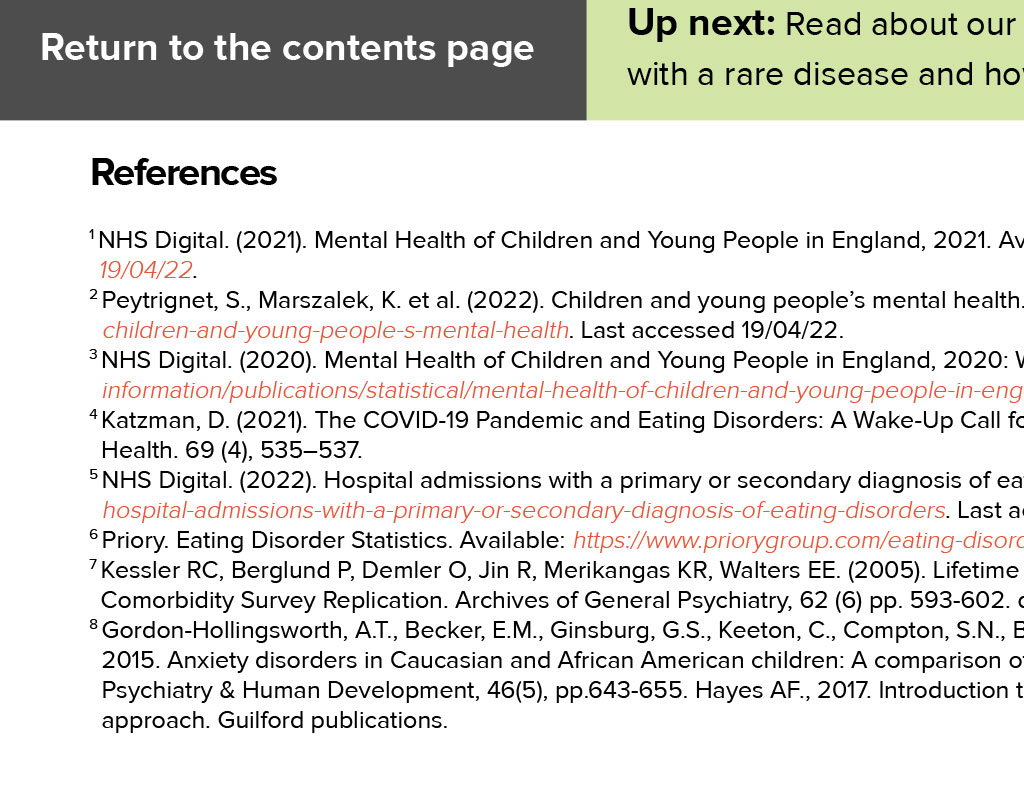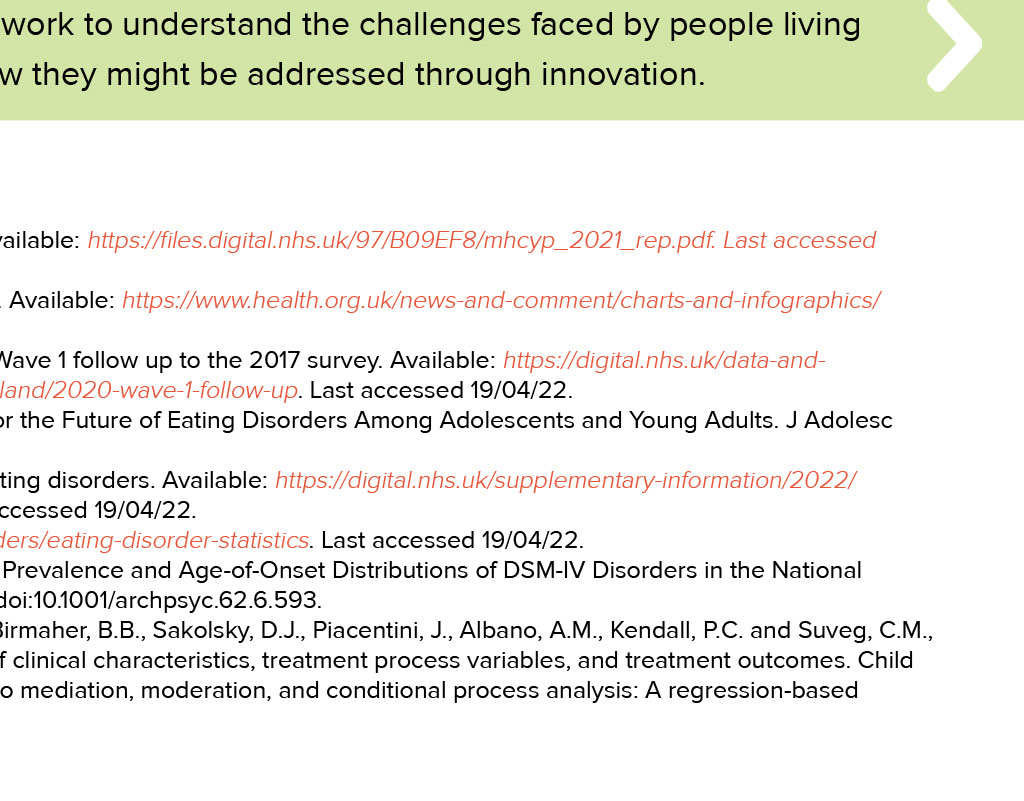




























Focusing on mental health in children and young people Dr Sarah Robinson, Director of Delivery at Eastern AHSN and clinical psychologist, explains how we are working with local services to improve mental health outcomes for young people M ental health remains a priority area for the team at Eastern AHSN and the need for innovations that enable access to evidence-based treatments has never been more important as we recover from the pandemic. While the impact that COVID-19 has had on young peoples mental health will become evident over the coming years, early signs are concerning: Rates of probable mental disorder in 6- to 16-year-olds increased between 2017 and 2021 from one in nine to one in six1,2. Children and young people with a probable mental disorder were more likely to say that lockdown had made their life worse than those who were psychologically well2. When it came to receiving help for mental health problems during the pandemic, almost 1 in 5 of 5- to 16-year-olds (or their guardians) with a probable mental disorder who tried to seek help for mental health problems reported that they didnt receive the help they needed3. At Eastern AHSN, we have a number of ongoing programmes aimed at supporting young people and enabling services to improve diagnosis and treatment of mental health conditions as early as possible. Focus ADHD The aim of the Focus ADHD programme is to enable services to improve how they assess children and young people for ADHD. This is done at The AHSN Network Focus ADHD programme won Best Mental Health Partnership with the NHS in the Health Service Journal (HSJ) Partnership Awards 2022 a regional level by: l Accelerating uptake and implementation of an objective ADHD assessment tool (measuring the three core components of attention, impulsivity and hyperactivity) to supplement current clinical assessment processes l Supporting changes in pathways, workforce and data collection. The increasing numbers of referrals with complexities, combined with reduced workforce capacity, have made it difficult to implement the changes within this programme across our region at speed. To help this, we are supporting providers to develop business cases and, in some cases, providing funding to support the pathway. Figures released during ADHD Awareness Month (October 2021) show that, since the start of the first demonstrator site in the East Midlands in 2017, 52,000 children across England have had an objective assessment for ADHD using the QbTest. In the East of England, we have rolled this programme out across four sites to date and 454 tests have been completed. It is already having a positive effect through reducing waiting lists and we are working hard to ensure best practices and positive experiences are shared across all sites through our community of practice. Central to the implementation of this project has been using our understanding of local pressures and working with our local network to understand workforce issues and where there are health inequalities, and how these can be mitigated. Eastern AHSN has brought together professionals from the whole ADHD pathway across our local health systems to provide education, inspiration, and support which is already benefiting children and their families. Dr Venkat Reddy, Consultant Neurodevelopmental Paediatrician and Lead Clinician at Cambridgeshire and Peterborough NHS Foundation Trust and Clinical Advisor for the Focus ADHD programme. Weve seen a real surge in referrals in our trust in the last 12 months, but using QbTest has been instrumental in providing clinicians supplementary data points upon which to base their diagnosis. It also gives parents an extra level of confidence that theres an objective test being used. - Dr Helen Alabede, East Suffolk and North East Essex Foundation Trust With FREED, Early intervention for eating disorders Since the onset of the COVID-19 pandemic, eating disorder experts youve suddenly got this source of hope that didnt exist before for people suffering this deadly illness. It couldnt have happened without the skills, knowledge and commitment of the AHSN from across the globe have observed a substantial increase in the number and severity of new and pre-existing young people suffering with eating disorders compared to prior years4. Compared to before the pandemic, there has been a dramatic (69%) increase in hospital admissions for eating disorders in young people5. Most eating disorders (extreme concern around eating, weight or shape, plus disordered eating) develop during adolescence; they are estimated to affect one in seven women over their lifetime and they have the highest mortality rates of any mental health disorder6. The AHSN Network is supporting the adoption of early intervention for eating disorder models of care across the East of England. In our region, we are embedding the First episode Rapid Early intervention for Eating Disorders (FREED) service model. This service offers young people with suspected anorexia nervosa, bulimia nervosa or binge eating disorder who have had the condition for less than three years to be triaged within 48 hours of the referral and begin treatment within four weeks. The programme aims to reduce the length of time young people have untreated eating disorders, improve their quality of life and reduce Simon Brown, Expert by experience and Chairman of the eating disorder nursing charity Personalised Eating Disorder Support (PEDS) the severity and longer-term impact of eating disorders on patients and families, as well as reducing day/inpatient admissions and bed days. We have successfully launched early intervention services across Norfolk and Waveney, Hertfordshire and West Essex, Suffolk and North East Essex, and Cambridge and Peterborough ICSs, meaning that young people across the Eastern region can be referred to a FREED service. We have helped embed FREED champions in each service to lead the adoption of the programme. We have established a community of practice to provide peer support and enable collaboration between FREED champions, service managers and regional NHS England and NHS Improvement colleagues to ensure the long-term sustainability of the service. To date, 86 16- to 25-year-olds across the Eastern region have been Simon Brown talks about the importance of early intervention in eating disorders supported to access NICE-recommended treatment for eating disorders through the FREED programme and, with the significant rise in referrals, this number is set to rise considerably in the coming year. We have also been supporting the team at Cambridgeshire and Peterborough to review and update a series of podcasts for people to use while they are in this service. Creating an interactive directory of UK adult community eating disorder services This electronic document provides a comprehensive list of all community eating disorder services across England, Scotland, Wales and Northern Ireland, including information on what geographical areas they serve and contact information for making further inquiries to make a referral. All UK universities and colleges are listed under their local community eating disorder service. The hope is that having this information freely available will help professionals and university health partners to make referrals and liaise with other community eating disorder services. As part of our work supporting mental health services in our region, a local NHS community eating disorders service requested support to streamline the process of referring young people to local community eating disorder services when they move to university. We worked with them and Beat, an eating disorder charity, to create a directory of all UK community eating disorder services, including information on what geographical areas they serve and contact information for making further inquiries to make a referral. You can read more about this work and access the directory here. Using health data to identify mental health problems in young people Eastern AHSN is a partner in FAIR TREATMENT (Federated analytics and artificial intelligence research across trusted research environments for child and adolescent mental health), led by researchers at the University of Cambridge. This sprint project is combining data research technologies to enable researchers to link and analyse data from different sources, including health, education and social care records, between three sites without the data needing to be moved. Learn more about our work in healthcare data in this article. Digital therapeutics for better mental health in children We are supporting innovator BFB Labs to evaluate the impact of Lumi Nova: Tales of Courage, an evidence-based therapeutic game that aims to enable children (7-12 years) to build life-long skills by learning how to self manage their fears, worries and anxieties. This includes common anxieties such as speaking in front of a group, fear of dogs or spiders, sleeping on their own and more. We are excited at the opportunity to support innovation at a younger age knowing that 50% of mental health problems are established by age 147. Watch the trailer for Lumi Nova: Tales of Courage by BfB Labs Eastern AHSN is a partner in a successful funding bid from the NIHR to pilot the use of the digital therapeutic tool across the East of England over 12 months to establish the clinical benefit in children. The research will explore the potential this innovation may have for addressing inequalities in healthcare, which is important as children from disadvantaged, marginalised, or ethnic minority communities are more likely to experience anxiety disorders, but are the least likely to access mental health services8. Weve supported the establishment of a Children and Families Advisory Group, which will be part of ensuring that patient voice is at the core of the research project. Manjul Rathee, Co-founder & CEO of BFB Labs: Working with Eastern AHSN has been one of the best partnerships weve experienced. As well as their pragmatic approach and understanding of an innovators journey, they were able to bring together a consortium of stakeholders including clinicians, commissioners and subject experts to help us realise this study. Within weeks, we had made progress that we expected to take months and we are so excited to see the results of the study later this year. Share this article Return to the contents page Get in touch If you want to learn more about any of these programmes or how we can support you to improve services, contact sarah.robinson@eahsn.org. Up next: Read about our work to understand the challenges faced by people living with a rare disease and how they might be addressed through innovation. References NHS Digital. (2021). Mental Health of Children and Young People in England, 2021. Available: https://files.digital.nhs.uk/97/B09EF8/mhcyp_2021_rep.pdf. Last accessed 19/04/22. 2 Peytrignet, S., Marszalek, K. et al. (2022). Children and young peoples mental health. Available: https://www.health.org.uk/news-and-comment/charts-and-infographics/ children-and-young-people-s-mental-health. Last accessed 19/04/22. 3 NHS Digital. (2020). Mental Health of Children and Young People in England, 2020: Wave 1 follow up to the 2017 survey. Available: https://digital.nhs.uk/data-andinformation/publications/statistical/mental-health-of-children-and-young-people-in-england/2020-wave-1-follow-up. Last accessed 19/04/22. 4 Katzman, D. (2021). The COVID-19 Pandemic and Eating Disorders: A Wake-Up Call for the Future of Eating Disorders Among Adolescents and Young Adults. J Adolesc Health. 69 (4), 535537. 5 NHS Digital. (2022). Hospital admissions with a primary or secondary diagnosis of eating disorders. Available: https://digital.nhs.uk/supplementary-information/2022/ hospital-admissions-with-a-primary-or-secondary-diagnosis-of-eating-disorders. Last accessed 19/04/22. 6 Priory. Eating Disorder Statistics. Available: https://www.priorygroup.com/eating-disorders/eating-disorder-statistics. Last accessed 19/04/22. 7 Kessler RC, Berglund P, Demler O, Jin R, Merikangas KR, Walters EE. (2005). Lifetime Prevalence and Age-of-Onset Distributions of DSM-IV Disorders in the National Comorbidity Survey Replication. Archives of General Psychiatry, 62 (6) pp. 593-602. doi:10.1001/archpsyc.62.6.593. 8 Gordon-Hollingsworth, A.T., Becker, E.M., Ginsburg, G.S., Keeton, C., Compton, S.N., Birmaher, B.B., Sakolsky, D.J., Piacentini, J., Albano, A.M., Kendall, P.C. and Suveg, C.M., 2015. Anxiety disorders in Caucasian and African American children: A comparison of clinical characteristics, treatment process variables, and treatment outcomes. Child Psychiatry & Human Development, 46(5), pp.643-655. Hayes AF., 2017. Introduction to mediation, moderation, and conditional process analysis: A regression-based approach. Guilford publications. 1